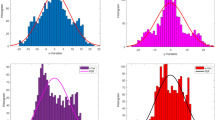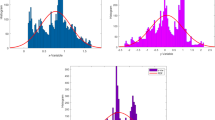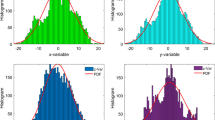Abstract
This research study involves modeling Newton–Leipnik attractors within the domain of fractional variable-order (FVO) dynamics using a nonlinear and adaptable radial basis function neural network (RBFNN). The numerical solution for the FVO Newton–Leipnik system is initially obtained using a numerical scheme based on the Caputo–Fabrizio derivative with variable order. This process is carried out across a range of different control parameters. A parametric model is also constructed using RBFNN, considering various system initial values. Multiple instances of chaos are calculated using a proposed computational model within the Newton–Leipnik system with varying fractional-order functions. This investigation aims to assess and comprehend the extent of sensitivity exhibited by chaotic behavior achieved through the computation of Lyapunov exponents. The performance of the proposed computational RBFNN model is validated using the RMSE statistic. The results closely align with those obtained through numerical algorithms based on the Caputo–Fabrizio derivative, demonstrating the high accuracy of the designed network.



























Similar content being viewed by others
Data Availability
There are no data associated with this research work.
References
Tarasov VE (2020) Mathematical economics: application of fractional calculus. Mathematics 8(5):660
Wang X, Wang Z, Lu J, Meng B (2021) Stability, bifurcation and chaos of a discrete-time pair approximation epidemic model on adaptive networks. Mathemat Comput Simulat 182:182–194
Rani DS, Singh DS, Mandal K (2020) Chaos within the Climate Variation: The Process of Energy Balance. Int J Adv Res Eng Technol 11(9):836–841
Luo C, Wang X (2013) Chaos generated from the fractional-order complex Chen system and its application to digital secure communication. Int J Modern Phys C 24(04):1350025
Jumarie G (2008) Stock exchange fractional dynamics defined as fractional exponential growth driven by (usual) Gaussian white noise. Application to fractional black-scholes equations. Insuranc Mathemat Econom 42:271–287
Jafari H, Ganji RM, Nkomo NS, Lv YP (2021) A numerical study of fractional order population dynamics model. Result Phys 27:104456
Li C, Peng G (2004) Chaos in Chen’s system with a fractional order. Chaos Solit Fract 22(2):443–450
Shah K, Arfan M, Ullah A, Al-Mdallal Q, Ansari KJ, Abdeljawad T (2022) Computational study on the dynamics of fractional order differential equations with applications. Chaos Solit Fract 157:111955
Shah K, Sarwar M, Abdeljawad T (2024) A comprehensive mathematical analysis of fractal-fractional order nonlinear re-infection model. Alexandria Eng J 103:353–365
Baleanu D, Jajarmi A, Sajjadi SS, Mozyrska D (2019) A new fractional model and optimal control of a tumor-immune surveillance with non-singular derivative operator. Chaos Interdiscipl J Nonlin Sci 28:083127
Baleanu D, Shekari P, Torkzadeh L, Ranjbar H, Jajarmi A, Nouri K (2023) Stability analysis and system properties of Nipah virus transmission: a fractional calculus case study. Chaos Solit Fract 166:112990
Defterli O, Baleanu D, Jajarmi A, Sajjadi SS, Alshaikh N, Asad JH (2022) Fractional treatment: an accelerated mass-spring system. Romanian Report Phys 74(4):122
Baleanu D, Arshad S, Jajarmi A, Shokat W, Ghassabzade FA, Wali M (2023) Dynamical behaviours and stability analysis of a generalized fractional model with a real case study. J Adv Res 48:157–173
Qi H, Zhao W (2022) Stability and bifurcation analysis of a fractional-order food chain model with two time delays. J Mathemat 2022:5313931
Ahmed N, Akgül A, Satti AM, Iqbal Z, Raza A, Rafiq M, Park C (2023) Analysis of the fractional polio model with the Mittag-Leffler kernels. Alexandria Eng J 64:657–967
Samko SG (1995) Fractional integration and differentiation of variable order. Anal Mathemat 21(3):213–236
Rech PC (2021) Dynamics of a four-bimensional system with cubic nonlinearities. Int J Bifurcat Chaos 31:2150012
Solís-Pérez JE, Gómez-Aguilar JF, Atangana A (2018) Novel numerical method for solving variable-order fractional differential equations with power, exponential and Mittag-Leffler laws. Chaos Soliton Fract 114:175–185
Alkahtani BST, Koca I, Atangana A (2016) A novel approach of variable order derivative: theory and Methods. J Nonlin Sci Appl 9(6):4867–4876
Verma A, Sumelka W, Yadav PK (2023) The numerical solution of nonlinear fractional lienard and duffing equations using orthogonal perceptron. Symmetry 15(9):1753
Atangana A, Botha JF (2013) A generalized groundwater flow equation using the concept of variable-order derivative. Boundary value prob 2013:1–11
Ardjouni A, Djoudi A (2020) Existence and uniqueness of positive solutions for first-order nonlinear Liouville-Caputo fractional differential equations. São Paulo J Mathemat Sci 14(1):381–390
Dlamini A, Goufo EFD, Khumalo M (2021) On the Caputo-Fabrizio fractal fractional representation for the Lorenz chaotic system. AIMS Mathemat 6(11):12395–12421
Gupta A, Kumar S (2021) Design of Atangana-Baleanu-Caputo fractional-order digital filter. ISA trans 112:74–88
Marlin BA (2002) Periodic orbits in the Newton-Leipnik system. Int J Bifurcat Chaos 12(03):511–523
Chen S, Zhang Q, Xie J, Wang C (2004) A stable-manifold-based method for chaos control and synchronization. Chaos Soliton Fract 20(5):947–954
Richter H (2002) Controlling chaotic systems with multiple strange attractors. Phys Lett A 300(2–3):182–188
Wang X, Tian L (2006) Bifurcation analysis and linear control of the Newton-Leipnik system. Chaos Soliton Fract 27(1):31–38
Sheu LJ, Chen HK, Chen JH, Tam LM, Chen WC, Lin KT, Kang Y (2008) Chaos in the Newton-Leipnik system with fractional order. Chao Soliton Fract 36(1):98–103
Saad KM, Srivastava R (2024) Non-standard finite difference and vieta-lucas orthogonal polynomials for the multi-space fractional-order coupled korteweg-de vries equation. Symmetry 16(2):242
Al Fahel S, Baleanu D, Al-Mdallal QM, Saad KM (2023) Quadratic and cubic logistic models involving Caputo-Fabrizio operator. Europ Phys J Special Top 232(14):2351–2355
Morales-Delgado VF, Gómez-Aguilar JF, Saad K, Escobar Jiménez RF (2019) Application of the Caputo-Fabrizio and Atangana-Baleanu fractional derivatives to mathematical model of cancer chemotherapy effect. Mathemat Method Appl Sci 42(4):1167–1193
Hioual A, Ouannas A, Grassi G, Oussaeif TE (2023) Nonlinear nabla variable-order fractional discrete systems: Asymptotic stability and application to neural networks. J Computat Appl Mathemat 423:114939
Kumar S, Chauhan RP, Momani S, Hadid S (2024) Numerical investigations on COVID-19 model through singular and non?singular fractional operators. Numerical Methods Partial Different Equat 40(1):e22707
Rehman KU, Shatanawi W (2024) Lie symmetry based neural networking analysis for Powell-Eyring fluid flow with heat and mass transfer effects. Int J Thermofl 22:100602
Raza A, Baleanu D, Cheema TN, Fadhal E, Ibrahim RI, Abdelli N (2023). Artificial intelligence computing analysis of fractional order COVID-19 epidemic model. AIP Advances, 13(8)
Bukhari AH, Sulaiman M, Raja MAZ, Islam S, Shoaib M, Kumam P (2020) Design of a hybrid NAR-RBFs neural network for nonlinear dusty plasma system. Alexandria Eng J 59(5):3325–3345
Bukhari AH, Shoaib M, Kiani AK, Chaudhary NI, Raja MAZ, Shu CM (2023) Dynamical analysis of nonlinear fractional order Lorenz system with a novel design of intelligent solution predictive radial base networks. Mathemat Comput Simul 213:324–347
Yousefpour A, Jahanshahi H, Castillo O (2022) Application of variable-order fractional calculus in neural networks: where do we stand? Europ Phys J Special Top 231(10):1753–1756
Shi R, Lu T, Wang C (2019) Dynamic analysis of a fractional-order model for hepatitis B virus with Holling II functional response. Complexity 2019:1097201
Jahanshahi H, Zambrano-Serrano E, Bekiros S, Wei Z, Volos C, Castillo O, Aly AA (2022) On the dynamical investigation and synchronization of variable-order fractional neural networks: the Hopfield-like neural network model. Europ Phys J Special Top 231(10):1757–1769
Parsa Moghaddam B, Yaghoobi S, Tenreiro Machado JA (2016) An extended predictor-corrector algorithm for variable-order fractional delay differential equations. J Computat Nonlin Dynam 1:1–11
Atangana A, Baleanu D (2016) New fractional derivatives with nonlocal and non-singular kernel: theory and application to heat transfer model. Thermal Sci 20(2):763–769
Liang L, Guo W, Zhang Y, Zhang W, Li L, Xing X (2020) Radial basis function neural network for prediction of medium-frequency sound absorption coefficient of composite structure open-cell aluminum foam. Appl Acoust 170:107505
Naz S, Raja MAZ, Kausar A, Zameer A, Mehmood A, Shoaib M, (2022) Dynamics of nonlinear cantilever piezoelectric-mechanical system: an intelligent computational approach. Mathemat Comput Simul 196:88–113
Rashedi KA, Ismail MT, Hamadneh NN, Wadi SA, Jaber JJ, Tahir M (2021) Application of radial basis function neural network coupling particle swarm optimization algorithm to classification of Saudi Arabia stock returns. J Mathemat 2021:1–8
Abu Arqub O, Rashaideh H (2018) The RKHS method for numerical treatment for integrodifferential algebraic systems of temporal two-point BVPs. Neural Comput Appl 30:2595–2606
Khan A, Saeed A, Gul T, Mukhtar S, Ali I, Jawad M (2021) Radiative swirl motion of hydromagnetic Casson nanofluid flow over rotary cylinder using Joule dissipation impact. Phys Scripta 96(4):045206
Abro KA, Atangana A (2020) A comparative analysis of electromechanical model of piezoelectric actuator through Caputo-Fabrizio and Atangana-Baleanu fractional derivatives. Mathemat Method Appl Sci 43(17):9681–9691
Liping C, Khan MA, Atangana A, Kumar S (2021) A new financial chaotic model in Atangana-Baleanu stochastic fractional differential equations. Alexandria Eng J 60(6):5193–5204
Acknowledgements
We are thankful to the reviewers and editor for their valuable suggestions to improve the quality of the manuscript. The authors would like to thank Prince Sultan University for their support.
Author information
Authors and Affiliations
Corresponding author
Ethics declarations
Conflict of interest
The authors declare that they have no Conflict of interest.
Additional information
Publisher's Note
Springer Nature remains neutral with regard to jurisdictional claims in published maps and institutional affiliations.
Rights and permissions
Springer Nature or its licensor (e.g. a society or other partner) holds exclusive rights to this article under a publishing agreement with the author(s) or other rightsholder(s); author self-archiving of the accepted manuscript version of this article is solely governed by the terms of such publishing agreement and applicable law.
About this article
Cite this article
Bashir, Z., Malik, M.G.A. & Hussain, S. A computational study of fractional variable-order nonlinear Newton–Leipnik chaotic system with radial basis function network. J Supercomput 81, 152 (2025). https://doi.org/10.1007/s11227-024-06492-0
Accepted:
Published:
DOI: https://doi.org/10.1007/s11227-024-06492-0




